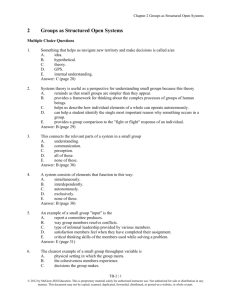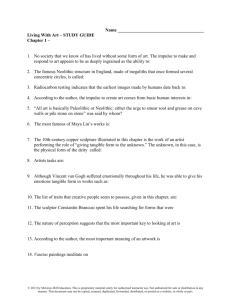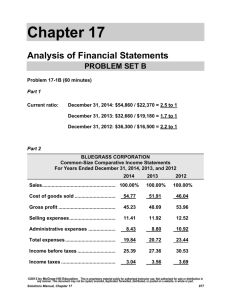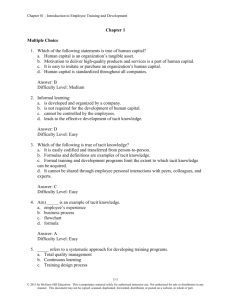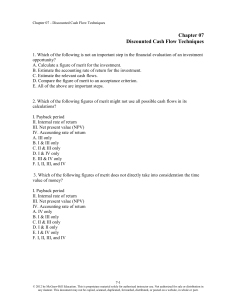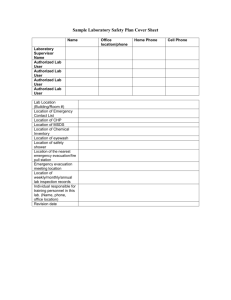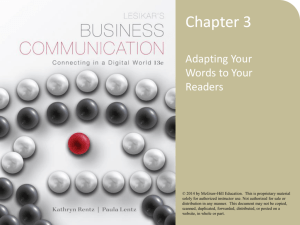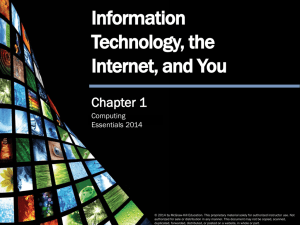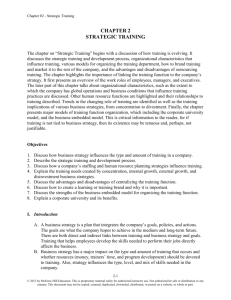Chapter 1 Introduction to Managing Operations
advertisement
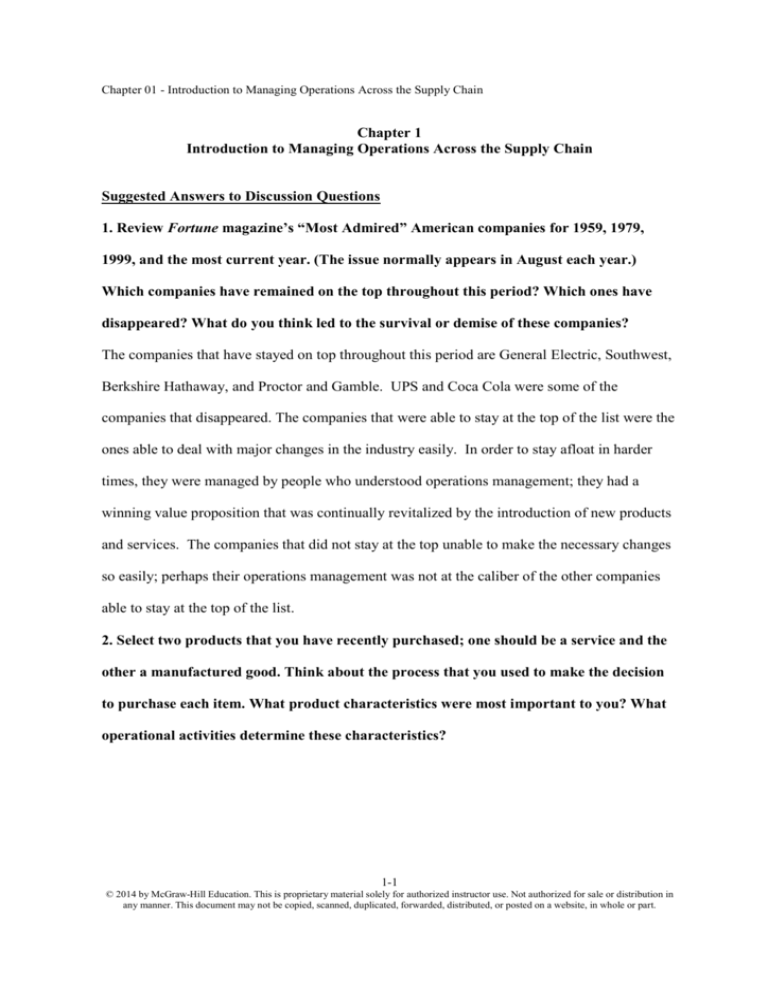
Chapter 01 - Introduction to Managing Operations Across the Supply Chain Chapter 1 Introduction to Managing Operations Across the Supply Chain Suggested Answers to Discussion Questions 1. Review Fortune magazine’s “Most Admired” American companies for 1959, 1979, 1999, and the most current year. (The issue normally appears in August each year.) Which companies have remained on the top throughout this period? Which ones have disappeared? What do you think led to the survival or demise of these companies? The companies that have stayed on top throughout this period are General Electric, Southwest, Berkshire Hathaway, and Proctor and Gamble. UPS and Coca Cola were some of the companies that disappeared. The companies that were able to stay at the top of the list were the ones able to deal with major changes in the industry easily. In order to stay afloat in harder times, they were managed by people who understood operations management; they had a winning value proposition that was continually revitalized by the introduction of new products and services. The companies that did not stay at the top unable to make the necessary changes so easily; perhaps their operations management was not at the caliber of the other companies able to stay at the top of the list. 2. Select two products that you have recently purchased; one should be a service and the other a manufactured good. Think about the process that you used to make the decision to purchase each item. What product characteristics were most important to you? What operational activities determine these characteristics? 1-1 © 2014 by McGraw-Hill Education. This is proprietary material solely for authorized instructor use. Not authorized for sale or distribution in any manner. This document may not be copied, scanned, duplicated, forwarded, distributed, or posted on a website, in whole or part. Chapter 01 - Introduction to Managing Operations Across the Supply Chain Student answers to this question will vary. The following is an example from one student: “Two products I have recently purchased were a sweater and a haircut. The process I used to make the decision to purchase the sweater was trying on the sweater in different colors, contemplating the purchase at home, waiting for sweater to go on sale, and then purchasing it. The process I used to make the decision about where to get my haircut included researching pictures of how I wanted my hair to look, asking advice about where to go from friends, researching online for reviews about stylists, and getting my haircut by that stylist. I wanted to make sure both products were going to satisfy me enough so that I wouldn’t regret either purchase. I had to be comfortable with both my sweater and my new hair style, luckily I was! I also wanted both my sweater and my hair style to last for a while to make them worth the cost. The operational activities that determine these characteristics are the manufacturing, shipping and selling the sweater in stores. If the sweater was poorly made and didn’t fit correctly, I would not have purchased it. If it was not available (on the shelf) I could not have purchased it. The operational activities that determine the characteristics of my hairstyle are the stylist arriving to work on time for my appointment, washing, cutting and blow drying my hair in a way that I was expecting (having sufficient capacity so that I did not have to wait too long). Since my hair was cut and styled the way I requested, I will be returning to that hair stylist. 3. What are the primary operations management decisions in each of the following corporations? 1-2 © 2014 by McGraw-Hill Education. This is proprietary material solely for authorized instructor use. Not authorized for sale or distribution in any manner. This document may not be copied, scanned, duplicated, forwarded, distributed, or posted on a website, in whole or part. Chapter 01 - Introduction to Managing Operations Across the Supply Chain Again, student answers will vary but may include the following elements. a. Marriott Hotels and Resorts: How to greet and treat customers during their stay, what services to supply to customers, how to check customers in so that they are not waiting for long periods of time to get to their rooms, how to deal with unhappy customers in order to keep them coming back, how to measure customer satisfaction. b. A private golf and tennis club: How to serve customers while playing tennis/golf so they continue to spend their money and play at this private course, what services to offer in order to keep customers happy. How to best manage the facilities and train employees. c. Ben & Jerry’s: What flavors to make, how much of each flavor to make, how to keep up with demand, what suppliers to use, how to measure customer satisfaction. d. ExxonMobil Corporation: How to manage exploration, extraction and refinement operations effectively and efficiently. What services are to be delivered, how to keep retail customers happy, how to deliver goods. 4. Consider the following processes that you frequently encounter as a college student. Describe each process and its input, activities, and outputs. What is being converted or transformed in each process? Who are the customers, suppliers, and stakeholders for each process? 1-3 © 2014 by McGraw-Hill Education. This is proprietary material solely for authorized instructor use. Not authorized for sale or distribution in any manner. This document may not be copied, scanned, duplicated, forwarded, distributed, or posted on a website, in whole or part. Chapter 01 - Introduction to Managing Operations Across the Supply Chain a. Enrolling in classes: Classes must be scheduled so that students can enroll in them, students communicate with advisor about necessary classes, students sign onto website and find suitable classes that fit together into schedule for each semester. The inputs of this process are the student’s and administrators’ time and problem solving effort. The activities are decision making, communicating, and scheduling so that everyone has a chance to take the classes they want each semester. The output is the student’s schedule and enrollment into classes. The student’s schedule is being transformed. The customer is the student, the stakeholders are the professors who get paid to teach the courses and the businesses that would like to hire students once they complete their courses. The supplier is the university. b. Taking a class: The process and activities of taking a class entail making it to class on time every session, studying before class to be able to follow along and participate, arriving with the correct materials in order to take notes and complete activities in class, and completing homework before it is due. The inputs are the knowledge of the professor and information contained in course materials, along with the student’s hard work, studying, participating, and physically going to class. The outputs are friends and education. The student is being transformed. The customer is the student. Or one might consider the business who would like to hire the student to be the customer. The supplier is the university. 1-4 © 2014 by McGraw-Hill Education. This is proprietary material solely for authorized instructor use. Not authorized for sale or distribution in any manner. This document may not be copied, scanned, duplicated, forwarded, distributed, or posted on a website, in whole or part. Chapter 01 - Introduction to Managing Operations Across the Supply Chain c. Buying a ticket for a play, concert, or basketball game: The process and activities of buying a ticket entail making a decision to buy the ticket, saving up the money, either ordering the ticket online or physically going to a ticket booth and purchasing the ticket. The inputs are time and money. The outputs are the experience of seeing a great play, concert, or basketball game and memories. The ownership of the ticket is being converted. The customer is the ticket purchaser; the stakeholder is the owner of the basketball team, or the director of the play, or the manager of the band. If no one purchases tickets, those stakeholders may no longer have jobs. The supplier is the team, the actors, or the band. 5. Recall the last time you went to a fast-food restaurant such as McDonald’s. Describe all of the goods and services that make up your total product experience. The goods that made up my experience were the actual food and drink that I purchased. The services were being greeted when I walked up to the counter, ordering my food, receiving my food in a timely manner along with my order being correct. The service of a clean restaurant also added to my total product experience. 6. The following firms have long been seen as having strong competitive advantages. Read about one of these companies. Also draw from your experience as a customer to identify that company’s competitive advantage. Discuss how operations management relates to the company’s competitive advantage. Student answers will vary. An example for Coca-Cola is: 1-5 © 2014 by McGraw-Hill Education. This is proprietary material solely for authorized instructor use. Not authorized for sale or distribution in any manner. This document may not be copied, scanned, duplicated, forwarded, distributed, or posted on a website, in whole or part. Chapter 01 - Introduction to Managing Operations Across the Supply Chain Coca-Cola’s success comes from its secret formula for its main product, Coca-Cola. It has been able to keep its formula a secret for so long that major competitors like Pepsi are having a hard to following in its footsteps. In order to stay at the top, Coca-Cola has recently been restructuring its supply chain so that they can keep their products in high demand. This new supply chain system will enable Coca-Cola products to keep shelves at stores like Wal-Mart and Meijer filled so that customers do not have to settle on other brands. Along with restructuring supply chain comes restructuring operations management. If the wrong distributer or bottler is employed or not enough products are produced, Coca-Cola’s profits and demand could suffer. 7. Why should a firm consider the position of stakeholders when evaluating operational alternatives? Consider the role of government and its impact. (Hint: Consider working conditions and pollution.) A firm should consider the position of stakeholders because they could have a big effect on the company along with the company’s profits. If a highly polluting firm does not make changes to make stakeholders happy (like environmentalists), then those stakeholders may alert the government through the EPA. The EPA could then research and investigate the company and if they found anything against the law, the EPA could bring that firm to court. This would effect its abilities to get stockholders, to keep its customers, run the business, and therefore to make a profit. 1-6 © 2014 by McGraw-Hill Education. This is proprietary material solely for authorized instructor use. Not authorized for sale or distribution in any manner. This document may not be copied, scanned, duplicated, forwarded, distributed, or posted on a website, in whole or part. Chapter 01 - Introduction to Managing Operations Across the Supply Chain 8. Most people have worked as “operations managers” at some time. Describe a job or experience that you had that involved the management of a process. Student answers will vary. A good example offered by an undergraduate is: “When I was a manager at a restaurant, it involved the management of a process. Every night I had to make sure that there were tables available for customers that had made reservations, and that no one was waiting too long for their tables, food, drinks, or bills. I had to put bigger tables in certain sections where I knew the more experienced wait staff would make the customers’ experience more enjoyable. I also had to go around to each table to make sure meals were satisfactory and did anything to make the customer’s experience at the restaurant pleasant enough to assure customer patronage.” Business Textbook Supply Chain Case – Teaching Notes I like to start my class with this case, because the product is familiar to students. Many of them are in the process of acquiring their books for the semester or term, so the idea of value and cost are fresh in their minds. Also, the technologies and markets involved are not terribly complex, yet there is a lot change going on that makes the discussion relevant and current. The overall goal of the case is to set the stage for a discussion of all the topics related to supply chain operations management. 1-7 © 2014 by McGraw-Hill Education. This is proprietary material solely for authorized instructor use. Not authorized for sale or distribution in any manner. This document may not be copied, scanned, duplicated, forwarded, distributed, or posted on a website, in whole or part. Chapter 01 - Introduction to Managing Operations Across the Supply Chain Synopsis: The case gives students an opportunity to step through a “value chain analysis” for a product and industry with which they have some familiarity. The steps of the analysis include: 1. Identify key players (critical customers) 2. Chart physical and information flows 3. Describe value proposition offered by each player 4. Describe primary value add for each player (who is responsible for key value elements?) 5. Identify market and technology dynamics 6. Ideas?? Considering the relationships and dynamics in the chain, how might we improve the value propositions? By analyzing these issues from the perspective of a book publisher, students can gain an appreciation for the different types of value created in supply chain operations, as well as the role that partnerships play in developing and delivering products. In addition, this particular industry situation provides a great example of the dynamics that govern supply chain operations management. Changing technologies and markets make it important for operations managers to continuously evaluate the value propositions that their companies offer, and how changing conditions may render them obsolete. 1-8 © 2014 by McGraw-Hill Education. This is proprietary material solely for authorized instructor use. Not authorized for sale or distribution in any manner. This document may not be copied, scanned, duplicated, forwarded, distributed, or posted on a website, in whole or part. Chapter 01 - Introduction to Managing Operations Across the Supply Chain Case Questions: The case questions guide the student through the value chain analysis identified above. 1. Draw a diagram that illustrates the textbook supply chain from the publishers' point of view. 2. Who are the various customers for textbooks? What do these customers want in terms of goods and services related to textbooks? From the publisher's point of view, who is the critical customer? 3. Who are the major players in the supply chain? What operational roles do they play in terms of creating value for the critical customers? 4. Given the anticipated changes in the market and in product and process technologies, how do you envision each supply chain player's role changing in the future? 5. What advice would you give to Dave Eisenhart regarding long-term operational changes the firm should consider? Case Analysis: 1. Draw a diagram that illustrates the textbook supply chain from the publishers' point of view. The diagram below identifies most of the major players in the traditional textbook supply chain. Students will quickly identify other channels of distribution as well, such as on-line retailers. I encourage them to concentrate first in thinking about the traditional channel that has hard bound books stored in inventory at several stages throughout the chain. You can ask the question of why inventory exists? Why do publishers revise books every 3 years? Or other questions just to get them thinking. 1-9 © 2014 by McGraw-Hill Education. This is proprietary material solely for authorized instructor use. Not authorized for sale or distribution in any manner. This document may not be copied, scanned, duplicated, forwarded, distributed, or posted on a website, in whole or part. Chapter 01 - Introduction to Managing Operations Across the Supply Chain Textbook supply chain from publisher’s perspective Sales Rep Professor Authors Paper Supplier order Student Ink Supplier Other Supplier Printer / Binder Publisher Dist Retail Carrier Designers Editors Material flows Information, currency flows (orders, payments) 2. Who are the various customers for textbooks? What do these customers want in terms of goods and services related to textbooks? From the publisher's point of view, who is the critical customer? 1-10 © 2014 by McGraw-Hill Education. This is proprietary material solely for authorized instructor use. Not authorized for sale or distribution in any manner. This document may not be copied, scanned, duplicated, forwarded, distributed, or posted on a website, in whole or part. Chapter 01 - Introduction to Managing Operations Across the Supply Chain I usually draw a table such as the one below. Ask the students to identify which value characteristics are most important and which are nice but not necessary. Using the idea of “order winners and qualifiers” is also useful here. Compare and contrast what the different customers want and identify conflicts. Ask how a publisher might make tradeoffs among these book characteristics in designing a new book. Customer Student Professor (critical customer because he/she makes the purchase decision) Retail bookstore owner What he/she cares about Price!!!, weight of the book, durability, ease of use (e.g., easy to read), Content fits course design, ease of use (course prep materials), currency of content, Price??, Durability!! (wants to re-sell the book as many times as possible), size (smaller is better to take less shelf space), 3. Who are the major players in the supply chain? What operational roles do they play in terms of creating value for the critical customers? Talk through the various roles, including: Retailer – storage and transfer of ownership Distributor/carrier – storage, transportation, availability Publisher/Authors – design, development Printer/suppliers – material transformations 4. Given the anticipated changes in the market and in product and process technologies, how do you envision each supply chain player's role changing in the future? 1-11 © 2014 by McGraw-Hill Education. This is proprietary material solely for authorized instructor use. Not authorized for sale or distribution in any manner. This document may not be copied, scanned, duplicated, forwarded, distributed, or posted on a website, in whole or part. Chapter 01 - Introduction to Managing Operations Across the Supply Chain Market changes: Constantly evolving business content More short courses, on-line courses, and other courses that do not need an entire textbook More case teaching Desire to combine content from multiple sources Technology changes: Print on demand technologies (make smaller print batches economical, even lot sizes of 1), in future each book will be printed on demand at the retail site “Custom published books” – combine materials from various sources e-books Self publishing – will authors need publishers in the future? ct ro n ic te xt ext nd t u o db ements Har r requir e s u m ea Mainstr t ex dt n ma de n o int Pr El e Readability (visual quality) Example: Educational Texts Today Time 1-12 © 2014 by McGraw-Hill Education. This is proprietary material solely for authorized instructor use. Not authorized for sale or distribution in any manner. This document may not be copied, scanned, duplicated, forwarded, distributed, or posted on a website, in whole or part. Chapter 01 - Introduction to Managing Operations Across the Supply Chain If e-books ever become mainstream, then the value provided by the printer, distributor, and retailer will be minimized. 5. What advice would you give to Dave Eisenhart regarding long-term operational changes the firm should consider? Some issues the publisher might consider: - forward integrate into retail and distribution of e-books? Think about value that the publisher creates for the author and how to protect against the threat of self publishing (key value provide might be marketing and sales functions, integration of authors’ ideas with other key knowledge sources, etc.) - Purchase or partner with competitors to gain access to wider scope of content – for example, McGraw Hill/Irwin has a deal with Harvard to include cases in their book/coursepacks I wrap up the discussion by pointing out the strategic and dynamic nature of managing operations spread across a supply chain. A sharp operations manager must stay abreast of: - changing market conditions and customer desires - competitor moves - changes in technology and capabilities of key partners and suppliers Overall, he/she must have a keen understanding of how his/her firm creates value today, and how that might be different tomorrow. 1-13 © 2014 by McGraw-Hill Education. This is proprietary material solely for authorized instructor use. Not authorized for sale or distribution in any manner. This document may not be copied, scanned, duplicated, forwarded, distributed, or posted on a website, in whole or part.
